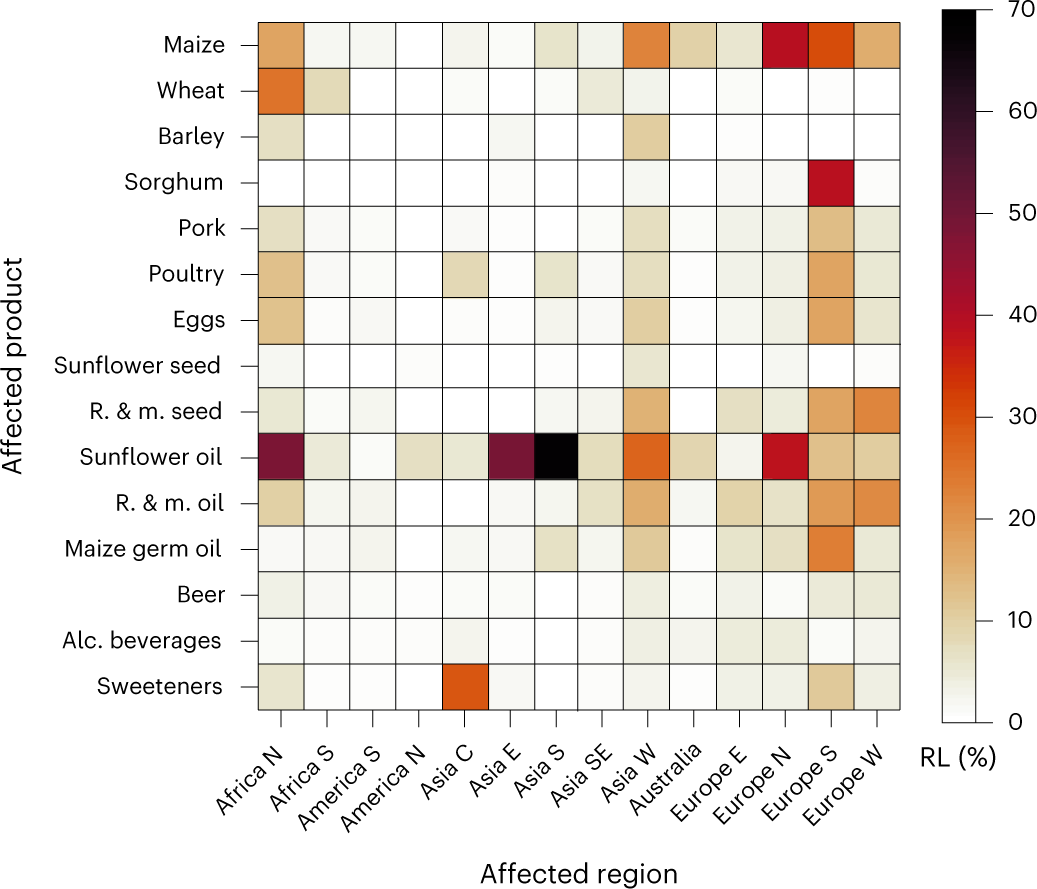
The authors of this article present a multi-layer network model that analyses the propagation of shocks in the global food trade system. The authors recognise that shocks, such as extreme weather events and political or geopolitical crises, have become more frequent over time. They therefore propose a model that simulates the complex interactions between countries, production processes, trade networks, and product allocation to study the impact of production shocks on food availability in different countries or regions.
The model addresses two main gaps in the capacity of existing tools to plan for food system impacts. Firstly, existing models have tended to treat each commodity in isolation, without accounting for impacts on products that rely on conversion of the original commodity further along the production chain. Secondly, impacts have been modelled based on food price spikes but since food crises are not always correlated with such spikes, a complementary model is needed.
The model acts in three steps:
- Allocation of the total product within country, e.g. to export, to further processing, to consumption, waste and stockpiling etc. The fractions assigned to each purpose are specific to each country and product.
- Trade between countries, i.e. imports and exports of products. In the model, trade is articulated by a network, where each entry in the network represents the share of exports from one country to another, and the network is weighted according to the proportions of product exported/imported in a given direction. The imports of a country for a specific product are determined by summing up the exports from other countries for that product, weighted by the trade network matrix.
- Production dependencies among products as a result of processing. Countries use different production processes to create and convert products. Each country has multiple production processes, and each process can produce multiple products. The specific amount of output product produced by each process depends on the inputs and is calculated using a mathematical function.
These three steps are visualised in Fig. 1.

Fig. 1, Laber et. al., 2023 Schematic representation of trade and production as a multilayer network for three countries and two products.
In each iteration, the production, trade, and allocation processes are carried out. The model captures the dynamics of changing product availability and trade relationships over time. To analyse the effects of a shock to the production of certain products in certain countries, the authors compare a baseline scenario with a shocked scenario. The relative loss of product availability in response to the shock is measured to assess the severity of the adverse effects on a country or region.
The model parameters and initial conditions are calibrated using supply. These tables provide information on product supply, use, and trade for the year 2013. By accounting for trade between countries and production dependencies between products based on processing, the model makes it possible to simulate and assess the effect of a locally confined event on the economy in distant places and enables a comparison of different response strategies.
The authors provide three hypothetical case studies based on the ongoing war in Ukraine, a major producer of maize, wheat, and sunflower seeds. In the first case, a complete loss of agricultural production in Ukraine leads to severe reductions in the availability of various products in different regions worldwide. The study also examines the impacts of shocks to specific products, such as maize and sunflower oil, and identifies critical suppliers and production inputs for Germany's pork availability. The impact of the first case is illustrated in Fig. 4, where RL is the relative loss.

Fig. 4, Laber et. al., 2023 A simultaneous shock to the production of all food products in Ukraine affects different world regions and products.
The study reveals the vulnerability of certain regions, such as southern and eastern Asia, northern Africa, and parts of Europe, to shocks in Ukrainian production. The impacts extend beyond the loss of specific products, affecting related products in different countries. The authors discuss the policy implications of their findings, suggesting that supply chain visibility and transparency are essential for identifying potential risks and developing contingency plans. Diversifying import sources and minimising food waste are also recommended as strategies to mitigate the effects of supply disruptions.
The authors acknowledge a number of limitations of the model, including:
- It does not capture the dynamical restructuring of supply relations that are likely to occur after a shock, such as trade relations in which a failing supplier might be replaced by a competitor, or production relations in which a product recipe is adapted following a change in availability of an ingredient.
- The need for more granular data in spatial resolution and product scope. For example, data on the subnational level would improve assessment for shocks such as natural disasters or extreme weather events that are spatially localised but do not stop at national borders. Extending the model to non-food input products, such as fertilisers or machinery, would create a more complete picture of a country’s dependencies.
- Reliance on linear production functions, in which the impact on inputs is proportionate to that on the outputs. However, there will be many shocks to production processes which do not have this linear relationship (for example, certain impacts on inputs may affect efficiencies of scale), and are therefore not captured by the model.
The study nonetheless emphasises the complexity of the global food system and the need for a multidimensional perspective when addressing food security challenges.
Abstract:
Dependencies in the global food production network can lead to shortages in numerous regions, as demonstrated by the impacts of the Russia–Ukraine conflict on global food supplies. Here we reveal the losses of 125 food products after a localised shock to agricultural production in 192 countries and territories using a multilayer network model of trade (direct) and conversion of food products (indirect), thereby quantifying 108 shock transmissions. We find that a complete agricultural production loss in Ukraine has heterogeneous impacts on other countries, causing relative losses of up to 89% in sunflower oil and 85% in maize via direct effects and up to 25% in poultry meat via indirect impacts. Whereas previous studies often treated products in isolation and did not account for product conversion during production, the present model considers the global propagation of local supply shocks along both production and trade relations, allowing for a comparison of different response strategies.
Reference: Laber, M., Klimek, P., Bruckner, M. et al 2023. Shock propagation from the Russia–Ukraine conflict on international multilayer food production network determines global food availability. Nature Food 4, 508–517.
Read the full article here.







Post a new comment »